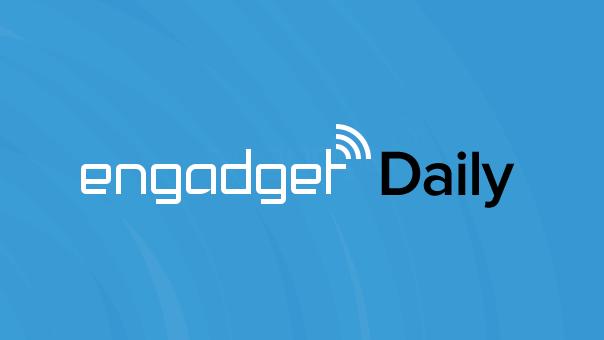tue
Latest

Smart arm bracelet warns of nighttime epileptic seizures
Nighttime epileptic seizures can be genuinely dangerous. If you have therapy-resistant epilepsy or a mental condition, you may have a one-in-five chance of dying from them. Thankfully, researchers at TUe may have a viable way of detecting and responding to those seizures in time to save lives. They've developed a smart arm bracelet, Nightwatch, that both detects signs of severe seizures and contacts care staff. It combines both a heart rate sensor and a motion sensor to look for both an unusually high heart rate as well as the rhythmic jolting characteristic of a seizure.

Quantum 'hashtags' may prove the existence of a strange particle
Hashtags could soon be useful for a lot more than fostering discussion on your favorite social network. Researchers have developed a hashtag-shaped quantum chip (shown below) that could confirm the existence of the oddball Majorana particle, which exists as both matter and antimatter at the same time. The team has learned that laying indium phosphide nanowires in the familiar '#' shape creates a closed circuit that lets the particles pass by each other and braid, rather that annihilating each other like they would on a single wire. Think of it like creating streets with intersections instead of a one-lane road -- the 'traffic' can actually get around without collisions.

Augmented reality may save you from road rage
When you're driving, it's all too easy to rage at fellow motorists who are either in a hurry or taking their sweet time. After all, you don't know the context. Are they in a real predicament, or just careless? If TUe researchers have their way, though, you'll know when to cut some slack. They've developed a mobile app, CarNote, that uses augmented reality (displayed in front of you through a periscope lens add-on) to let fellow drivers signal their intents and feelings. If you're in a rush to the hospital, for instance, you can notify commuters behind you so they don't honk their horns or chase you down. There are limits to how often you can use it, so habitual speeders can't just leave it on to excuse their behavior.

Artificial synapse could be key to brain-like computing
If you're going to craft brain-like computers, it stands to reason that you'd want to replicate brain-like behavior right down to the smallest elements, doesn't it? Sure enough, researchers have managed just that. They've developed an artificial synapse that imitates the real thing by both learning and remembering whenever electrical signals cross -- most previous attempts at this can only manage one action at a time. You only have to discharge and recharge the synapse at specific voltages to program it, and it promises to be far more power-efficient than conventional approaches to brain-like operation.

DNA 'computers' could lead to self-activated smart pills
Imagine a pill that knew if you were ill enough to need drugs, and wouldn't release chemicals if it thought you didn't need it. That's the breakthrough that's been made at Eindhoven University in the Netherlands by a team of researchers ld by Maarten Merkx. The team has harnessed the power of DNA itself to form an organic computer that performs crude calculations on the state of your health.

Nanowires help produce hydrogen fuel using sunlight
You ideally want to produce clean hydrogen fuel using clean sources, and Dutch researchers have taken a big step toward making that a practical reality. They've built a solar cell that uses a grid of gallium phosphide nanowires to make hydrogen gas from water. The approach gets a useful yield of about 2.9 percent in lab tests. That may not sound like much, but it's about 10 times more effective than previous techniques and uses 10,000 times less exotic material.

Engadget Daily: Amazon's first store, HTC's new selfie phone and more!
Today, we go hands-on with HTC's Desire Eye, learn about Amazon's first brick-and-mortar store, create a comic strip from text messages, and more. Read on for all our news highlights from the last 24 hours. You know you want to.

Solar Team Eindhoven crafts solar-powered family car (video)
The solar-powered cars we've seen to date are usually built for just one person -- not very useful when many of us need to carry passengers. TU/e's Solar Team Eindhoven just brought some much-needed realism on that front by unveiling Stella, which it claims is the world's first solar-powered family car. The vehicle's combination of efficient solar cells with lightweight construction allows such radical concepts as back seats and a trunk while maintaining a 373-mile range. The barebones design won't rival most modern cars for luxury, but it's also energy-positive -- in typical use, it can contribute back to the power grid. You may even see it outside of competitions; while Stella is designed with October's World Solar Challenge in mind, Solar Team Eindhoven plans to make the car road-legal. Let's hope we catch it putting around Dutch streets. [Image credit: Bart van Overbeeke]

New high-precision eye surgery robot helps doctors stay sharp
A researcher at the Netherland's Eindhoven University of Technology has invented a new type of eye surgery robot designed to steady the ophthalmologist's hands and minimize error -- always a good thing when it comes to having needles and knives near your peepers. Kind of like an Igor to a mad scientist, the robot is considered a "slave" to its "master" doctor, who controls the automaton's arms using two joysticks. The doctor is still in charge of the cuts, but the technology makes sure the MD jabs that needle in at the exact same entry point each time without shaking to minimize ocular marring. Another notable feature is the robot's ability to switch between tools quickly, ensuring that if this whole doctor thing doesn't work out, it'll at least have a job at Hibachi waiting. Jump past the break to check out the full PR.

Dutch scientists develop half million euro, 'affordable' super laser
The folks at Eindhoven University of Technology (TU/e) have lovingly referred to their latest contribution to the world of science as the "poor man's X-FEL." An X-FEL, or X-ray Free-electron Laser, is like a super strong video microscope that converts electrons to X-rays to observe high-speed molecular movement. TU/e's super laser alternative depends solely on a very specific bunching of electrons to do the same thing, allowing for a much smaller (it fits on a tabletop), much cheaper setup. With an estimated cost of half a million euro, the laser is hardly cheap, but it's far more affordable than the competition: Stanford's X-FEL runs hundreds of millions of dollars, and measures a whole kilometer. TU/e researchers admit that their laser can't do everything that an X-FEL can, but, hey, you get what you pay for. Up next for TU/e? In vitro pork products. Yummy.

Guust Hilte's tactile texting device solves the 'every pixel feels the same' problem (video)
Moving away from buttons on phones has lead to a higher level of design purity, but has also made life a lot more difficult for the blind or seeing impaired -- or anyone who doesn't want to look at their phone while texting. We've seen how solutions like the Brailliant-32 can let users interact with mobile devices, but that's hardly portable. Guust Hilte's device is. Looking like a cross between an egg and a rubber stamp, or perhaps the abdomen of a Cyclocosmia spider, it features a series of what Hilte calls gullies on the top that users can trace over with their thumb to enter letters, shown after the break (complete with chill Röyksopp soundtrack). However, that's just a prototype, a Masters project at the Eindhoven University of Technology, with the ultimate goal to integrate the thing into the back of phones. Hilte's vision is users flipping over their celly, entering their message, and then sending away without looking. We think the same could be done without flipping, instead using your index finger, and finally making use of all that wasted space 'round back. %Gallery-100358% [Thanks, Fabian Hemmert]





